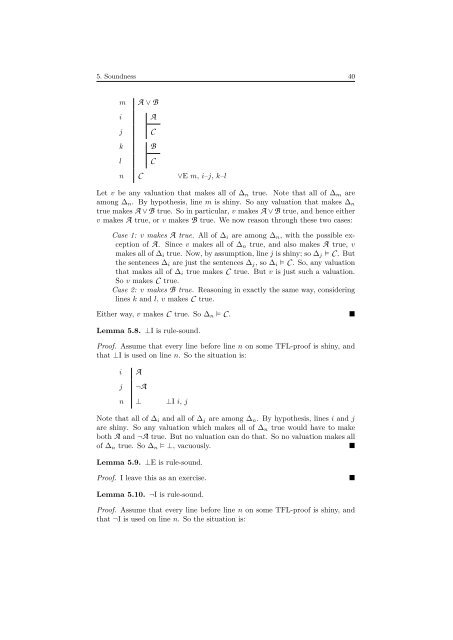Metatheory - University of Cambridge
Metatheory - University of Cambridge
Metatheory - University of Cambridge
You also want an ePaper? Increase the reach of your titles
YUMPU automatically turns print PDFs into web optimized ePapers that Google loves.
5. Soundness 40<br />
m<br />
i<br />
j<br />
k<br />
l<br />
A ∨ B<br />
A<br />
C<br />
B<br />
C<br />
n C ∨E m, i–j, k–l<br />
Let v be any valuation that makes all <strong>of</strong> ∆ n true. Note that all <strong>of</strong> ∆ m are<br />
among ∆ n . By hypothesis, line m is shiny. So any valuation that makes ∆ n<br />
true makes A ∨ B true. So in particular, v makes A ∨ B true, and hence either<br />
v makes A true, or v makes B true. We now reason through these two cases:<br />
Case 1: v makes A true. All <strong>of</strong> ∆ i are among ∆ n , with the possible exception<br />
<strong>of</strong> A. Since v makes all <strong>of</strong> ∆ n true, and also makes A true, v<br />
makes all <strong>of</strong> ∆ i true. Now, by assumption, line j is shiny; so ∆ j ⊨ C . But<br />
the sentences ∆ i are just the sentences ∆ j , so ∆ i ⊨ C . So, any valuation<br />
that makes all <strong>of</strong> ∆ i true makes C true. But v is just such a valuation.<br />
So v makes C true.<br />
Case 2: v makes B true. Reasoning in exactly the same way, considering<br />
lines k and l, v makes C true.<br />
Either way, v makes C true. So ∆ n ⊨ C .<br />
■<br />
Lemma 5.8. ⊥I is rule-sound.<br />
Pro<strong>of</strong>. Assume that every line before line n on some TFL-pro<strong>of</strong> is shiny, and<br />
that ⊥I is used on line n. So the situation is:<br />
i<br />
A<br />
j ¬A<br />
n ⊥ ⊥I i, j<br />
Note that all <strong>of</strong> ∆ i and all <strong>of</strong> ∆ j are among ∆ n . By hypothesis, lines i and j<br />
are shiny. So any valuation which makes all <strong>of</strong> ∆ n true would have to make<br />
both A and ¬A true. But no valuation can do that. So no valuation makes all<br />
<strong>of</strong> ∆ n true. So ∆ n ⊨ ⊥, vacuously.<br />
■<br />
Lemma 5.9. ⊥E is rule-sound.<br />
Pro<strong>of</strong>. I leave this as an exercise.<br />
■<br />
Lemma 5.10. ¬I is rule-sound.<br />
Pro<strong>of</strong>. Assume that every line before line n on some TFL-pro<strong>of</strong> is shiny, and<br />
that ¬I is used on line n. So the situation is:
















